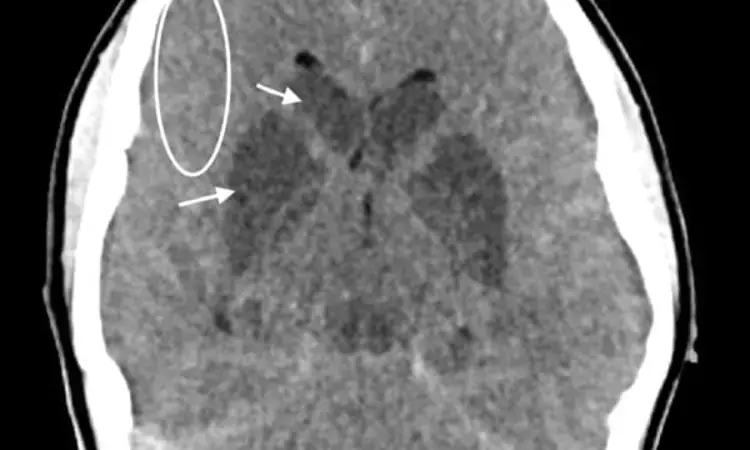- Home
- Medical news & Guidelines
- Anesthesiology
- Cardiology and CTVS
- Critical Care
- Dentistry
- Dermatology
- Diabetes and Endocrinology
- ENT
- Gastroenterology
- Medicine
- Nephrology
- Neurology
- Obstretics-Gynaecology
- Oncology
- Ophthalmology
- Orthopaedics
- Pediatrics-Neonatology
- Psychiatry
- Pulmonology
- Radiology
- Surgery
- Urology
- Laboratory Medicine
- Diet
- Nursing
- Paramedical
- Physiotherapy
- Health news
- Fact Check
- Bone Health Fact Check
- Brain Health Fact Check
- Cancer Related Fact Check
- Child Care Fact Check
- Dental and oral health fact check
- Diabetes and metabolic health fact check
- Diet and Nutrition Fact Check
- Eye and ENT Care Fact Check
- Fitness fact check
- Gut health fact check
- Heart health fact check
- Kidney health fact check
- Medical education fact check
- Men's health fact check
- Respiratory fact check
- Skin and hair care fact check
- Vaccine and Immunization fact check
- Women's health fact check
- AYUSH
- State News
- Andaman and Nicobar Islands
- Andhra Pradesh
- Arunachal Pradesh
- Assam
- Bihar
- Chandigarh
- Chattisgarh
- Dadra and Nagar Haveli
- Daman and Diu
- Delhi
- Goa
- Gujarat
- Haryana
- Himachal Pradesh
- Jammu & Kashmir
- Jharkhand
- Karnataka
- Kerala
- Ladakh
- Lakshadweep
- Madhya Pradesh
- Maharashtra
- Manipur
- Meghalaya
- Mizoram
- Nagaland
- Odisha
- Puducherry
- Punjab
- Rajasthan
- Sikkim
- Tamil Nadu
- Telangana
- Tripura
- Uttar Pradesh
- Uttrakhand
- West Bengal
- Medical Education
- Industry
Noncontrast CT sufficient for identifying patients of acute ischaemic stroke likely to benefit from endovascular thrombectomy

Noncontrast CT sufficient for identifying patients of acute ischaemic stroke likely to benefit from endovascular thrombectomy suggests a new study published in the Lancet.
Recent evidence suggests a beneficial effect of endovascular thrombectomy in acute ischaemic stroke with large infarct; however, previous trials have relied on multimodal brain imaging, whereas non-contrast CT is mostly used in clinical practice.
In a prospective multicentre, open-label, randomised trial, patients with acute ischaemic stroke due to large vessel occlusion in the anterior circulation and a large established infarct indicated by an Alberta Stroke Program Early Computed Tomographic Score (ASPECTS) of 3–5 were randomly assigned using a central, web-based system (using a 1:1 ratio) to receive either endovascular thrombectomy with medical treatment or medical treatment (ie, standard of care) alone up to 12 h from stroke onset. The study was conducted in 40 hospitals in Europe and one site in Canada. The primary outcome was functional outcome across the entire range of the modified Rankin Scale at 90 days, assessed by investigators masked to treatment assignment. The primary analysis was done in the intention-to-treat population. Safety endpoints included mortality and rates of symptomatic intracranial haemorrhage and were analysed in the safety population, which included all patients based on the treatment they received. This trial is registered with ClinicalTrials.gov, NCT03094715.
Findings
From July 17, 2018, to Feb 21, 2023, 253 patients were randomly assigned, with 125 patients assigned to endovascular thrombectomy and 128 to medical treatment alone. The trial was stopped early for efficacy after the first pre-planned interim analysis. At 90 days, endovascular thrombectomy was associated with a shift in the distribution of scores on the modified Rankin Scale towards better outcome (adjusted common OR 2·58 [95% CI 1·60–4·15]; p=0·0001) and with lower mortality (hazard ratio 0·67 [95% CI 0·46–0·98]; p=0·038). Symptomatic intracranial haemorrhage occurred in seven (6%) patients with thrombectomy and in six (5%) with medical treatment alone.
Endovascular thrombectomy was associated with improved functional outcome and lower mortality in patients with acute ischaemic stroke from large vessel occlusion with established large infarct in a setting using non-contrast CT as the predominant imaging modality for patient selection.
Reference:
Endovascular thrombectomy for acute ischaemic stroke with established large infarct: multicentre, open-label, randomised trial. Prof Martin Bendszus, Prof Jens Fiehler, Fabien Subtil, Susanne Bonekamp, Anne Hege Aamodt, Prof Blanca Fuentes, et al. Show all authors. Published:October 11, 2023DOI:https://doi.org/10.1016/S0140-6736(23)02032-9
Keywords:
Noncontrast CT, sufficient, for, identifying, patients, acute, ischaemic, stroke, likely, benefit, from, endovascular, thrombectomy, lancet, Prof Martin Bendszus, Prof Jens Fiehler, Fabien Subtil, Susanne Bonekamp, Anne Hege Aamodt, Prof Blanca Fuentes
Dr. Shravani Dali has completed her BDS from Pravara institute of medical sciences, loni. Following which she extensively worked in the healthcare sector for 2+ years. She has been actively involved in writing blogs in field of health and wellness. Currently she is pursuing her Masters of public health-health administration from Tata institute of social sciences. She can be contacted at editorial@medicaldialogues.in.
Dr Kamal Kant Kohli-MBBS, DTCD- a chest specialist with more than 30 years of practice and a flair for writing clinical articles, Dr Kamal Kant Kohli joined Medical Dialogues as a Chief Editor of Medical News. Besides writing articles, as an editor, he proofreads and verifies all the medical content published on Medical Dialogues including those coming from journals, studies,medical conferences,guidelines etc. Email: drkohli@medicaldialogues.in. Contact no. 011-43720751


